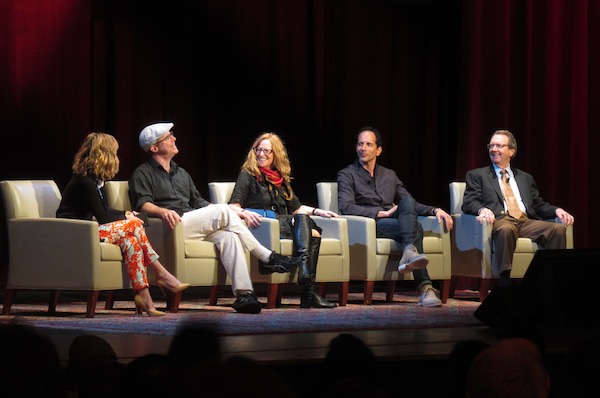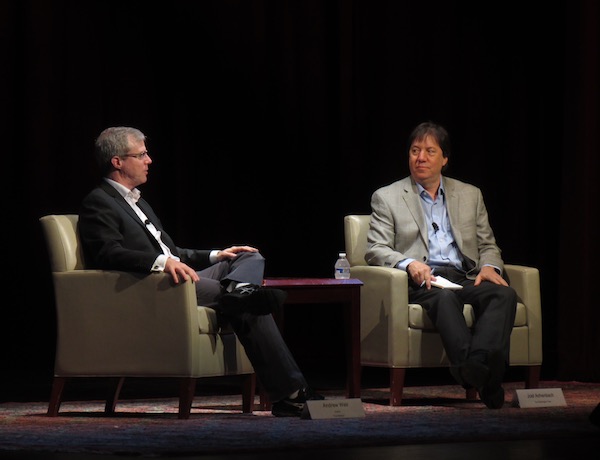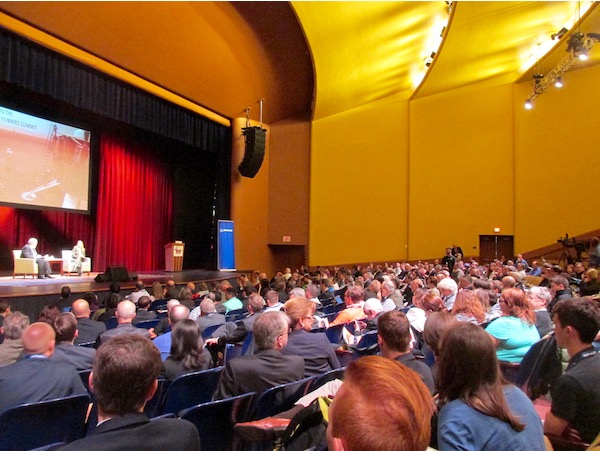
A year on Marsby Dwayne Day
|
| Human missions to Mars, or at least talking about humans on Mars, is all the rage these days, and H2M has made a pretty impressive effort at taking the lead. |
H2M seems to have upped its game recently. Their website is slick, featuring computer animations and links to video recordings of most of the presentations at their conference, much of which was live-streamed. H2M has a lot of corporate sponsorship, including industry bigwigs Lockheed Martin and Boeing. Both companies had numerous placards around the conference lobby demonstrating their ties to Mars and human spaceflight programs. Boeing was showcasing the SLS, although surprisingly did not feature its previous Mars mission design study. Lockheed Martin, in particular, wanted people to realize how many American spacecraft they built that successfully reached Mars.
There were a lot of events and a few debuts at H2M. Lockheed Martin unveiled their Mars Base Camp concept, which they claim could be implemented by 2028 (if sufficient funding is available, of course.) You can add this Mars mission design to the Planetary Society’s JPL/Aerospace Corporation-developed mission concept for a Mars orbiting mission unveiled in 2015. And that is in addition to Boeing’s 2014 mission proposal. Of course, many hyperventilating space enthusiasts are waiting for Moses (aka Elon Musk) to descend from Mount Sinai later this year with his ideas on Mars colonization, what one writer described as the “agonizing months until we find out what Musk's plan is.” Those are only the corporate proposals, because just about anybody who messes around with Kerbal Space Program probably has their own plans for getting to Mars—or will fill the bottom half of the Internet with endlessly repetitive comments about why their plan is superior to NASA’s.
The H2M conference was for the most part well-organized and efficiently-run. Compared to a few past conferences, the number of non-serious talks was relatively low. Robert Zubrin again used illustrations of his late 1980s Mars Direct proposal that have the look and feel of cave drawings compared to Lockheed Martin and Boeing with their slick computer graphics. Zubrin’s message, and his method of presentation, have changed little in a quarter century, and what was once fresh and exciting now doesn’t seem to do much to excite the base. Perhaps this is why H2M appeared to have twice as many people in attendance as I counted at last August’s Mars Society Conference. (See “Red planet rumble,” The Space Review, August 17, 2015.) Of course Buzz Aldrin was also there, pushing a complex and head-scratching Mars exploration and settlement plan that nobody seems enthused about except Buzz.
| Instead of an iconic single photo like Buzz Aldrin standing on the Moon, we may have an entire 3D Mars landscape, complete with touch and smell. |
Some of the talks and panel discussions were quite substantive and illuminating. A panel on virtual reality showcased a number of new technologies and applications of existing ones that were eye opening. For instance, a JPL group has developed a virtual reality planning tool for robotic Mars exploration that allows mission operators in different locations to essentially step onto the Mars landscape around a rover and identify features, such as rocks and terrain, for the rover to sample. Their actions, like pointing at specific locations, can then be directly translated into commands for the rover. Another group has created a virtual reality model of one of the Apollo landing sites along with an interactive lunar rover which will enable a user to actually drive around the surface just like the Apollo astronauts did.
Back around 2007 or so, I remember seeing an interview with a NASA engineer who was working on developing the communications system for the Altair lunar lander for the now-canceled Constellation program. What was fascinating to me was hearing him describe the challenges of incorporating high-definition video into a communications system that was going to be bandwidth-limited. But looking at the virtual reality demonstrations at H2M I was struck by how obsolete even very high definition video will be if humans ever walk on Mars. Bandwidth at Mars will be better than today, although still limited, but it seems highly likely that astronauts and their vehicles will be equipped with an array of video and other sensors (LIDAR? FLIR?) that will gather tremendous amounts of three-dimensional information about their local environment to be stored onboard the spacecraft and eventually returned to Earth, where scientists and engineers will incorporate it into highly detailed virtual reality simulations of the exploration site. Instead of an iconic single photo like Buzz Aldrin standing on the Moon, we may have an entire 3D Mars landscape, complete with touch and smell. (According to scientists, Mars stinks.)
 A panel discusses the connection between Hollywood and Mars. From left: Keri Kukral, moderator; author Andy Weir; Ann Merchant, Science and Entertainment Exchange of the National Academies; Robert Palumbo of the National Geographic Channel; and Scott Hubbard, Stanford University. (credit: D. Day) |
Several entertainment organizations used the H2M conference to discuss their upcoming projects. One is a movie, The Space Between Us, scheduled to debut in August. It tells the story of the first child born on Mars, in secret, at a private six-person base. Gary Oldman is not playing a villain for once, but a kind and caring billionaire (there are a lot of them around) who decides to bring the boy, now a teenager, back to Earth. The teen does what teens do and sneaks out of the facility to meet a girl who he has been communicating with for years—who was never aware that he was living on Mars the entire time and has recently returned to Earth. Giving part of the story away, he meets up with her and she doesn’t believe his crazy story until confronted with the truth. Although the movie is clearly intended as a young adult romance along the lines of the tearjerker The Fault in Our Stars and not aimed at middle-aged males (with a hidden romantic streak) like myself, the trailer and a couple of scenes were much better than I would have expected. The film looks like it actually has a deeper message, with the boy discovering just how beautiful and wonderful Earth is, even as it is crushing his heart.
| There was no Mars One, the oft-maligned plan for a one-way trip to the red planet. There was also no SpaceX. |
Robert Palumbo of the National Geographic Channel discussed the upcoming six-part docudrama Mars that will debut on his channel in November. Palumbo co-produced the show with Ron Howard, who knows a thing or two about fact-based entertainment set in space. Although he did not show any clips, Palumbo did explain the premise. Set later in the 21st Century, the series focuses on the first Mars colonization mission, which goes badly awry when the six-person crew lands far off course and nowhere near their prepositioned supplies. Palumbo said that one of the issues the writing team faced was finding ways to put the crew in constant peril that were believable and science-based—no more meteor showers puncturing spacecraft at critical moments (see “Planet Hollywood, part 1: Mission to Mars”, The Space Review, September 21, 2009). The drama is intercut with interviews with current-day Mars experts. Mars journalist extraordinaire Leonard David has authored the accompanying book, which will be gorgeously illustrated.
 Author Andy Weir is interviewed on stage by Washington Post reporter Joel Achenbach. (credit: D. Day) |
Andy Weir was in many ways the star of the conference, doing a one-on-one interview with my compadre Washington Post reporter Joel Achenbach as well as participating in a panel discussion. Weir is an amusing interviewee with an occasionally macabre sense of humor, at one point making a serial killer joke. Weir explained aspects of the book that he would write differently if he was doing it today. For instance, when someone asked why the Mars mission in his book was all-government, he said that he was trying to base it on what his audience would recognize, noting that when he was writing it, SpaceX was still a relatively-unknown company and the concept of public-private partnerships in space was less developed. He also said that now that water has been found on Mars, he would not have had his hero Mark Watney go through all the trouble of manufacturing it and nearly killing himself several times: “I would have simply had them land where the water was,” he said. Of course, this would have forced Weir to find other ways of nearly killing Watney, again and again.
Weir said that his next book concerns a lunar colony and that he thought about including Watney, but decided against it because he did not want him to be the protagonist. If Watney was in the book, the readers would expect him to be the hero.
 The audience at the Humans to Mars Summit. (credit: D. Day) |
There were several things missing from the conference. There was no Mars One, the oft-maligned plan for a one-way trip to the red planet. There was also no SpaceX. The company’s sponsorship consisted of supplying lanyards with their logo for participant badges, but nobody was there to discuss Elon Musk’s Mars plans or the robotic mission that might (bets, anyone?) take place in 2018. These days SpaceX has become synonymous with Mars, even though the company so far has only tweeted about it, which is still enough to induce a nerdgasm around the world. Mention SpaceX and Mars plans and some fanboys faint, hallucinate, or start speaking in tongues, convinced that Mars Nirvana is upon us. As a not-so-subtle counterpoint, Lockheed Martin distributed t-shirts with a rock concert world tour list of the company’s Mars missions on the back, making the point that most of the spacecraft that have already reached Mars or landed on it possessed the company’s DNA. A quick list:
Viking 1
Viking 2
Pathfinder/Sojourner
Mars Global Surveyor
2001 Mars Odyssey
Spirit
Opportunity
Mars Reconnaissance Orbiter
Phoenix
Curiosity
Maven
Insight
| And so the faithful preach to each other and don’t find many converts to their religion, only increased devotion to their faith. |
But what was really missing at the H2M Summit was what was missing from all discussions of sending humans to Mars: a compelling explanation of why anybody should spend all that money to send people there. For decades we have had many justifications for human space missions to Mars—science, destiny, settlement, a “second home for humanity”—none of them so far sufficiently overarching or convincing to many people, certainly not enough to get humans out of low Earth orbit. The only consensus is that we need a consensus, not what it should be.
And so the faithful preach to each other and don’t find many converts to their religion, only increased devotion to their faith. Elon Musk wants to build a colony on Mars to serve as an insurance policy in case Earth is destroyed, and perhaps attract people who want to retire there, although most retirees that I know want to move someplace warm with a golf course and a pool so the grandkids will visit, not live in a cave on a cold, lifeless world that smells bad. Perhaps one of the reasons that Musk has generated such a cult following is not simply his can-do attitude after decades of fanboy frustration with NASA, but because if a miracle occurs and he could do it with his own money, then nobody really needs find a compelling rationale anymore. It simply bypasses the whole thorny logic problem by pretending that it doesn’t exist.
As the old saying goes, when all is said and done, a lot more is said than done. A year on Mars is two Earth years. We still have six months to go in this one. Six more months of talking about Mars. And when that is done, we’ll start talking about Mars some more.